
The Burgdorferkrieg (German : Burgdorf war) or Kyburgerkrieg (German : Kyburg war) was a war in 1383-84 between the counts of Neu-Kyburg and the city of Bern for supremacy in the County of Burgundy in what is now Switzerland.

The Burgdorferkrieg (German : Burgdorf war) or Kyburgerkrieg (German : Kyburg war) was a war in 1383-84 between the counts of Neu-Kyburg and the city of Bern for supremacy in the County of Burgundy in what is now Switzerland.
The counts of Kyburg were a medieval noble family in central and northern Switzerland and Swabia. Throughout the 12th and 13th centuries they had expanded in power and influence. In 1250/51 the childless Hartmann IV of Kyburg gave the western part of the property with the center of Burgdorf to his nephew Hartmann V. After Hartmann V's death Count Rudolf von Habsburg took over the administration of the western section of the Kyburg lands and eventually reunited them. The family of Neu-Kyburg began to rule the united Kyburg lands as Habsburg vassals. In 1322, the brothers Eberhard II and Hartmann II of Neu-Kyburg started fighting with each other over who would inherit the undivided lands. The fighting led to the "fratricide at Thun Castle" where Eberhard killed his brother Hartmann. To avoid punishment by his Habsburg overlords, Eberhard fled to Bern. In the following year, he sold the town of Thun, its castle and the land surrounding Thun to Bern. Bern granted the land back to Eberhard as a fief and the Neu-Kyburgs became connected to Bern, but was often in conflict with the city. [1]
In the 14th century, the Neu-Kyburgs became increasingly indebted. On 11 November 1382, Count Rudolf II of Neu-Kyburg, launched a raid against the city of Solothurn to try and force the city to forgive his debts. For the city of Bern, this attack on an allied represented an excellent opportunity for the city to break its ties with the Neu-Kyburgs.
The city prepared by acquiring loans from Basel and weapons from Lucerne. They convinced the Neu-Kyburg's patron, the Austrian Duke Leopold III of Habsburg to not interfere. They then got promises of military support from Savoy, Neuchâtel and for the first time, based on the Federal Charter of 1353, the Swiss Confederation. [2]
Bern began the war by attacking Neu-Kyburg vassals in the Emmental and Oberaargau regions. This was followed in March 1383 by the main attack on the Neu-Kyburg administrative center at the castle and the town of Burgdorf. The Bernese-Solothurn army was supported with troops from the Forest Cantons, Lucerne, Zurich, Neuchatel and Savoy and were armed with catapults and primitive guns. Because Count Rudolf II had died before the war began, Burgdorf was defended by Rudolf's uncle, Berchtold I. Under Berchtold, Burgdorf withstood a 45-day siege. An attempt to negotiate a cease-fire on 21 April 1383, between Bern and the citizens of Burgdorf against the Neu-Kyburgs was also unsuccessful. [2]
Beset by enormous burdens of war and civil unrest at home, the Bernese Council sought Confederation mediation to end the war. On 5 April 1384, the Neu-Kyburgs agreed to sell the towns and castles of Burgdorf and Thun to Bern for 37,800 guilders. These two towns would allow Bern to expand into the Bernese Oberland, the Emmental and largest markets in the region. Bern accepted the treaty on 7 April and ended the war. For the Neu-Kyburgs, the loss of Burgdorf and Thun spelled the end of their power. The family was given the rights to Laupen Castle, but had limited freedoms. They were not allowed to move freely, had limited military rights and mandatory Confederation arbitration in disputes. [2]

The canton of Bern, or Berne, is one of the 26 cantons forming the Swiss Confederation. Its capital city, Bern, is also the de facto capital of Switzerland. The bear is the heraldic symbol of the canton, displayed on a red-yellow background.
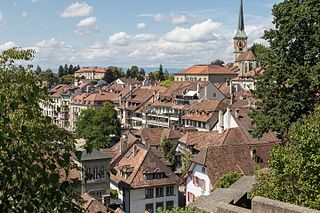
Burgdorf is the largest city in the Emmental in the canton of Bern in Switzerland. It was the capital of the district of the same name until 2010, when it became part of the new Emmental district.

The early history of Switzerland begins with the earliest settlements up to the beginning of Habsburg rule, which in 1291 gave rise to the independence movement in the central cantons of Uri, Schwyz, and Unterwalden and the growth of the Old Swiss Confederacy during the Late Middle Ages.

The Old Swiss Confederacy began as a late medieval alliance between the communities of the valleys in the Central Alps, at the time part of the Holy Roman Empire, to facilitate the management of common interests such as free trade and to ensure the peace along the important trade routes through the mountains. The Hohenstaufen emperors had granted these valleys reichsfrei status in the early 13th century. As reichsfrei regions, the cantons of Uri, Schwyz, and Unterwalden were under the direct authority of the emperor without any intermediate liege lords and thus were largely autonomous.

Districts of Switzerland are a political subdivision for cantons. In the federally constituted Switzerland, each canton is completely free to decide its own internal organisation. Therefore, there exists a variety of structures and terminology for the subnational entities between canton and municipality, loosely termed districts. Most cantons are divided into Bezirke. They are also termed Ämter, Amtsbezirke, district or distretto. The Bezirke generally provide only administration and court organization. However, for historical reasons districts in cantons Grisons and Schwyz are their own legal entities with jurisdiction over tax and often have their own Landsgemeinde.
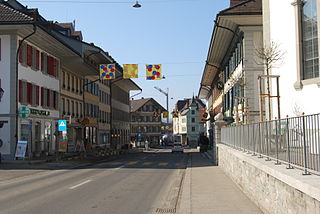
Huttwil is a municipality in the Oberaargau administrative district in the Swiss canton of Bern.
Wiedlisbach is a municipality in the Oberaargau administrative district in the canton of Bern in Switzerland.

The County of Kyburg probably came into existence in the 11th century and is first mentioned in 1027. After 1053 it was a possession of the counts of Dillingen. It was greatly expanded with the extinction of the House of Lenzburg in 1173.
The Kyburg family was a noble family of grafen (counts) in the Duchy of Swabia, a cadet line of the counts of Dillingen, who in the late 12th and early 13th centuries ruled the County of Kyburg, corresponding to much of what is now Northeastern Switzerland.

The Raron affair was a 15th-century rebellion in the Valais against the power of a local noble family, the Raron family. The rebellion brought several cantons of the Swiss Confederation into conflict with each other and threatened a civil war in the Confederation. While Bern was initially successful, they were eventually forced to surrender most of their gains.
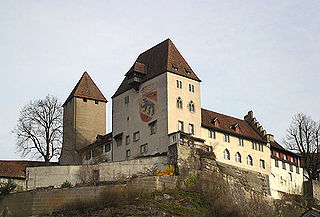
Burgdorf Castle is a castle in the municipality of Burgdorf in the canton of Bern in Switzerland. It is a Swiss heritage site of national significance.

Nidau Castle is a castle in the municipality of Nidau of the Canton of Bern in Switzerland. It is a Swiss heritage site of national significance.

Oberhofen Castle is a castle in the municipality of Oberhofen of the Canton of Bern in Switzerland. It is a Swiss heritage site of national significance.
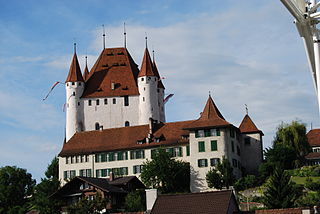
Thun Castle is a castle in the city of Thun, in the Swiss canton of Bern. It was built in the 12th century, today houses the Thun Castle museum, and is a Swiss heritage site of national significance.
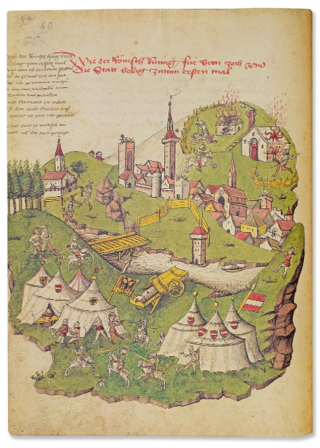
The Battle of Schosshalde was fought between the imperial city of Bern and the House of Habsburg on 27 April 1289 just outside Bern. Though the premise of the battle was over Bern's refusal to pay imperial taxes, the battle represented the growing power struggle between the many states in Swabia. It allowed King Rudolf I to further expand Habsburg influence in Swabia, but it preserved Bern's status as an imperial city, and likely was a factor in the formation of the Old Swiss Confederacy in 1291, as multiple Swiss states grew worried at the growing encroachment of the Habsburgs.
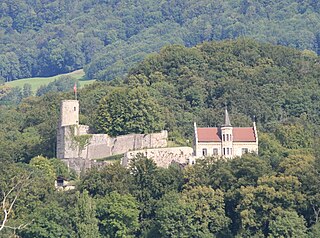
Bipp Castle is a partially ruined castle in the municipality of Oberbipp of the Canton of Bern in Switzerland.

Wiedlisbach Castle is a former tower house and defensive tower in the municipality of Wiedlisbach of the Canton of Bern in Switzerland.

Weissenburg Castle is a ruined castle in the municipality of Därstetten of the Canton of Bern in Switzerland.
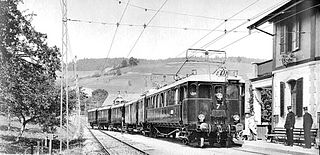
The Burgdorf–Thun railway is a railway line in Switzerland, which was built by the Burgdorf-Thun-Bahn. The line from Burgdorf via Konolfingen to Thun was opened by the company in 1899 as the first electrified mainline railway in Europe. It is now part of BLS AG.
The Solothurn–Langnau railway is a railway line in the Emmental in Switzerland. It was built by the Emmentalbahn, which was based in Burgdorf. The line runs from Solothurn via Burgdorf to Langnau im Emmental. It is now part of BLS AG.